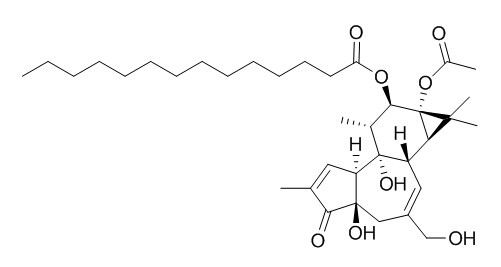12-O-tetradecanoylphorbol-13-acetate
12-O-tetradecanoylphorbol-13-acetate has skin tumor-promoting potential, it induces endogenous FBXO10 mRNA and FBXO10 protein in Jurkat cells, a human T cell line. It provokes cell motility through regulating the expression and function of S100A14 in a KLF4-dependent manner.
Inquire / Order:
manager@chemfaces.com
Technical Inquiries:
service@chemfaces.com
Tel:
+86-27-84237783
Fax:
+86-27-84254680
Address:
1 Building, No. 83, CheCheng Rd., Wuhan Economic and Technological Development Zone, Wuhan, Hubei 430056, PRC
Providing storage is as stated on the product vial and the vial is kept tightly sealed, the product can be stored for up to
24 months(2-8C).
Wherever possible, you should prepare and use solutions on the same day. However, if you need to make up stock solutions in advance, we recommend that you store the solution as aliquots in tightly sealed vials at -20C. Generally, these will be useable for up to two weeks. Before use, and prior to opening the vial we recommend that you allow your product to equilibrate to room temperature for at least 1 hour.
Need more advice on solubility, usage and handling? Please email to: service@chemfaces.com
The packaging of the product may have turned upside down during transportation, resulting in the natural compounds adhering to the neck or cap of the vial. take the vial out of its packaging and gently shake to let the compounds fall to the bottom of the vial. for liquid products, centrifuge at 200-500 RPM to gather the liquid at the bottom of the vial. try to avoid loss or contamination during handling.
Sci Rep.2017, 7(1):3249
Int. J. Mol. Sci. 2022, 23(3),1696.
Food Analytical Methods2020, 1-10
PLoS One.2022, 17(4):e0267007.
Antioxidants (Basel).2022, 11(8):1471.
Applied Biological Chemistry2020, 63:37.
J Agric Food Chem.2018, 66(1):351-358
Antioxidants (Basel).2020, 9(2): E119
Nutrients.2021, 13(1):254.
Journal of Research in Pharmacy.2022, 26(6):p1752-1757.
Related and Featured Products
J Biol Chem. 2014 Mar 28;289(13):9089-99.
12-O-tetradecanoylphorbol-13-acetate promotes breast cancer cell motility by increasing S100A14 level in a Kruppel-like transcription factor 4 (KLF4)-dependent manner.[Pubmed:
24532790]
The S100 protein family represents the largest subgroup of calcium binding EF-hand type proteins. These proteins have been reported to be involved in a wide range of biological functions that are related to normal cell development and tumorigenesis. S100A14 is a recently identified member of the S100 protein family and differentially expressed in a number of different human malignancies. However, the transcriptional regulation of S100A14 and its role in breast cancer needs to be further investigated.
METHODS AND RESULTS:
Here, we determined that 12-O-tetradecanoylphorbol-13-acetate (TPA) up-regulated the expression of KLF4 and facilitated its binding directly to two conserved GC-rich DNA segments within the S100A14 promoter, which is essential for the transactivation of KLF4 induced S100A14 expression. Furthermore, stable silencing of KLF4 significantly suppressed breast cancer cell migration induced by TPA.
CONCLUSIONS:
Collectively, these results offer insights into the fact that TPA provokes cell motility through regulating the expression and function of S100A14 in a KLF4-dependent manner.
J Pharm Pharmacol. 2013 Aug;65(8):1223-30.
Structure-dependent inhibitory effects of synthetic cannabinoids against 12-O-tetradecanoylphorbol-13-acetate-induced inflammation and skin tumour promotion in mice.[Pubmed:
23837590]
METHODS AND RESULTS:
Twenty-three analogues of synthetic cannabinoids were isolated from, and identified as adulterants in, illegal drugs distributed in the Tokyo metropolitan area, and were examined for their inhibitory effects on the induction of oedema in mouse ears by 12-O-tetradecanoylphorbol-13-acetate (TPA). Furthermore, selected cannabinoids, JWH-018, -122 and -210, were studied for their effects on carcinogenesis induced in mouse skin initiated with 7,12-dimethylbenz[a]anthracene (DMBA) and promoted by 12-O-tetradecanoylphorbol-13-acetate. Among cannabinoids, naphthoylindoles mostly exhibited superior inhibitory effects against 12-O-tetradecanoylphorbol-13-acetate-induced ear oedema and, especially, JWH-018, -122 and -210 showed potent activity with 50% inhibitory dose (ID50) values of 168, 346 and 542 nm, respectively (an activity corresponding to that of indometacin (ID50 = 908 nm)). Furthermore these three compounds also markedly suppressed the tumour-promoting activity of 12-O-tetradecanoylphorbol-13-acetate.
CONCLUSIONS:
This is the first report indicating the structure-activity relationships for the anti-inflammatory activity of synthetic cannabinoids on 12-O-tetradecanoylphorbol-13-acetate-induced inflammation in mice. Naphthoylindoles, JWH-018, -122 and -210, had the most potent anti-inflammatory activity and also markedly inhibited tumour promotion by 12-O-tetradecanoylphorbol-13-acetate in the two-stage mouse skin carcinogenesis model. The present results suggest that synthetic cannabinoids, such as JWH-018, -122 and -210, may be used as cancer chemopreventive agents in the future.
Vet Pathol. 2013 Sep;50(5):903-8.
Tumor promotion by 12-O-tetradecanoylphorbol-13-acetate in an ultra-short-term skin carcinogenesis bioassay using rasH2 mice.[Pubmed:
23610217]
METHODS AND RESULTS:
Assessment of the skin tumor-promoting potential of 12-O-tetradecanoylphorbol-13-acetate (TPA) after initiation with 7,12-dimethylbenz[a]anthracene (DMBA) was conducted using rasH2 transgenic (Tg) mice and their nontransgenic (non-Tg) littermates. Mice were treated with DMBA (50 μg/100 μL acetone) on clipped back skin at the commencement of the study, and 1 week thereafter, 12-O-tetradecanoylphorbol-13-acetate was applied at 8 μg/200 μL or 4 μg/200 μL acetone, once or twice weekly, for 7 weeks.In conclusion, skin promotion effects could be detected within only 8 weeks in the rasH2 mice, and the concentration of 4 μg 12-O-tetradecanoylphorbol-13-acetate once weekly was sufficient as a positive control.
CONCLUSIONS:
This short-term skin carcinogenesis bioassay using rasH2 mice could represent a useful tool for the assessment of drug and chemical safety with cutaneous treatment.
Mol Carcinog. 2015 Feb;54(2):134-47.
Differential 12-O-Tetradecanoylphorbol-13-acetate-induced activation of rat mammary carcinoma susceptibility Fbxo10 variant promoters via a PKC-AP1 pathway.[Pubmed:
24008983]
12-O-tetradecanoylphorbol-13-acetate (TPA) induced activation of a 4.2 kb WF Fbxo10 promoter region, but lower levels of activation of the homologous WKY Fbxo10 promoter region.
METHODS AND RESULTS:
Using general and specific protein kinase inhibitors, we identified a protein kinase C (PKC) pathway that mediated 12-O-tetradecanoylphorbol-13-acetate activation. We narrowed the possible PKCs to a member of the atypical PKC isoforms, namely PKCµ. We also determined that activator protein 1 (AP1) family member c-Fos mediated 12-O-tetradecanoylphorbol-13-acetate activation of the 4.2 kb WF Fbxo10 promoter. 12-O-tetradecanoylphorbol-13-acetate was shown to induce endogenous FBXO10 mRNA and FBXO10 protein in Jurkat cells, a human T cell line, with a maximal level of expression from 1.5 to 2.5 h after exposure.
CONCLUSIONS:
These results indicate that FBXO10/Fbxo10 expression is regulated by a PKC-dependent pathway acting through c-Fos, which binds AP1-specific DNA elements in Mcs5a1.



